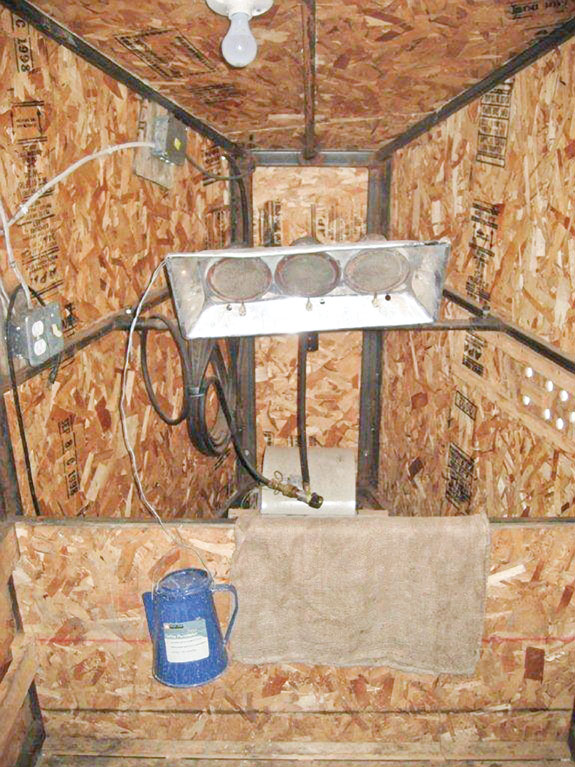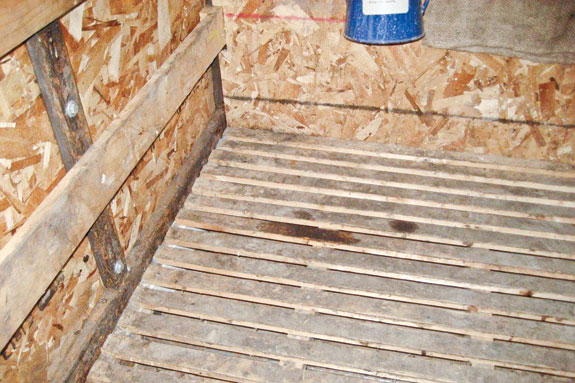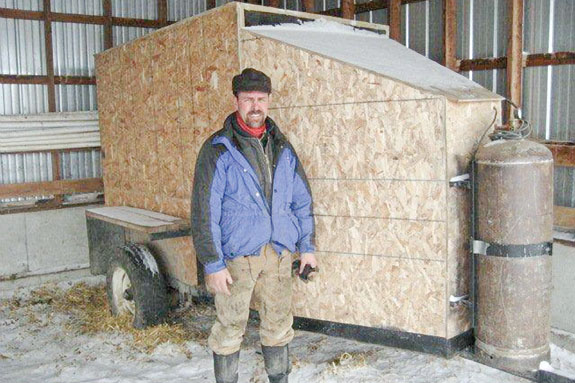Hair dryers, electric blankets, warm water baths or the floorboard of the pickup cab with the heater on can be effective in both drying and warming cold calves, and so can warming boxes.
These boxes don’t have to be fancy, but do need to hold enough heat to get calves warm and dry.
Warming boxes can be purchased commercially or, like in the case of the IX Ranch, custom-designed and built to fit a specific need.
The need on the IX Ranch is to get several calves at one time warm, dry and back out with their mamas in a short period of time.
Several years ago, Richard Roth, IX co-owner, couldn’t find equipment like this on the market, so this ranch came up with its own.

Roth shares, “The calf warmer was designed and built by Todd Amsbaugh (pictured below), our ranch manager.
He has been with us for over 18 years and is quite a hand.” Amsbaugh used his welding and construction skills to put wheels under the IX’s own mobile calf “sauna.”
Located in north-central Montana near Big Sandy, the multi-generational IX Ranch, which turns out quality feeder cattle, calves more than 3,000 head of females in March and April.
Last year in March, average daily temperatures were 32 degrees, with an average of 4 feet of snow and wind. Getting calves dry can be challenging, and sometimes as many as 10 calves need dried off at one time.
To make the IX’s warming box transportable to calving pastures, Amsbaugh used an old boat trailer for the base.

He then used plywood to build the boxed enclosure. Propane burners provide the box’s heat, and a large fan was installed to circularly push the warm air through the chamber.
Roth reports, “The warmer is designed to allow constant air flow up under the calf in a circular motion.
Having the calf up off the floor and air around it speeds up the drying process.” It takes about one hour for a calf to dry and be back with its mother to nurse. ![]()
Cold, wet and wind negatively affect newborns
Environmental stress such as wet and cold on many ranches in spring can be rougher on calves than dry cold and snow.
Wet and cold calves are already more prone to cold stress or hypothermia and, when temperatures plummet, precipitation negatively affects their survival.
Dr. Dee Whittier, extension veterinarian at the Virginia-Maryland Regional College of Veterinary Medicine, explains that newborn calves are most at risk because they are wet and because they have a large surface area in relation to their total body mass.
“Calves are not fully capable of maintaining temperature the first several hours of life. Newborn calves have a circulatory system that is less able to respond to cold changes as compared to more mature animals.”
Wind and humidity further take warmth away from calves, and cold surfaces do too. Cattle, in general, will lose much more body heat if they lie on snow, ice or frozen ground, points out Whittier, than if they can rest on dry bedding or grass. He says, “Snow or ice from freezing rain on calves dramatically increases heat loss.”

Combine any two – cold air temperature, wind or a wet calf, and hypothermia and death can result without human intervention.
Rectal temperature is the most accurate method of determining if a calf is experiencing hypothermia.
Extension educators, including Dr. Russ Daly, extension veterinarian at South Dakota State University, explain that mild hypothermia is when core body temperature drops below 100 degrees. Normal body temperature (as measured with a rectal thermometer) is 100.5 degrees to 102.5 degrees.
Severe hypothermia is when the core body temperature drops below 94 degrees, and when vital organs are cold and impaired brain function results.
As body temperature drops below 86 degrees, signs of life are hard to detect.
They advise producers to exercise caution when rewarming cold calves. If using home-constructed warming boxes, be sure to consider temperature regulation, because calves can die if they become overheated. Whittier’s advice is a calf is warm enough when a rectal thermometer reads 100 degrees. Furthermore, thermostatic control can help maintain consistent temperatures.
Also consider ventilation of these boxes to prevent buildup of carbon monoxide and moisture, and sanitation to prevent disease spread between calves.
Air movement from a fan, for example, as in the IX’s box, is important to prevent hot spots and ensure thorough calf warming.
Like many things in the cattle business, there is no one-size-fits-all warming method for calving season.
However, lending a hand to newborns, especially in cold weather, by making sure they suckle and receive colostrum soon after birth, and are dry and warm, can go a long way toward keeping calves alive and having more product to sell on marketing day. ![]()
PHOTOS
Top: In order to pair up mother with calf again, Richard Roth explains they write the cow’s ID number with permanent marker on surveyors’ tape, which is cut and tied around a calf’s neck.
Middle photos: Inside views of the IX’s custom-designed and built multiple-calf warmer. The warmer is designed with raised, slatted flooring, keeping calves off the base floor. This allows for air to flow all around the animals and speeds up the drying process. It takes about one hour for a calf to dry.
Bottom: IX Ranch Manager Todd Amsbaugh is pictured with the mobile warming box he designed and built for multiple-calf use on Montana’s expansive IX Ranch. Photos by Richard Roth.







